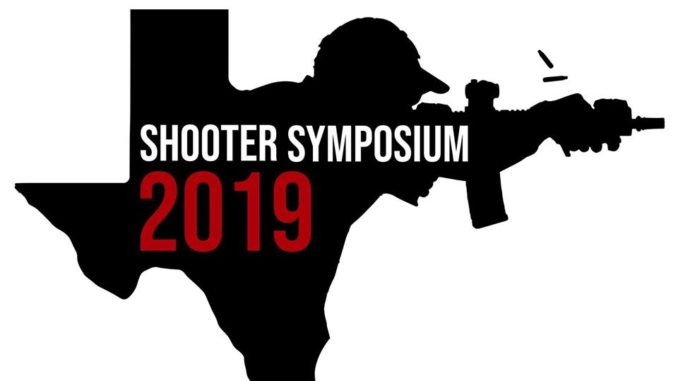
Author’s note: This After Action Report/review is not all-inclusive. I want to give readers an idea of what to expect from not only the Shooter Symposium but also each instructor without spoiling the entire event. Wanting to know what else each has to offer? Go sign up for a class of your own!
Shooter Symposium 2019 Quick Guide
Shooter Symposium 2019 Briefing
Location:
The Ranch: Eagle Lake, Texas
Weather:
Sunny, low to mid 80’s. Nice breeze on day 1, with little-to-no wind on days 2 and 3. Intermittent drizzle morning of day 2. Torrential downpour late morning of day 3.
Equipment:
| Glock 34/17 Build: | FN 509 Tactical: |
| Glock 34 Gen 4 Frame | Leupold DeltaPoint Pro 2.5 MOA Dot |
| Brownells Glock 17 Optics Ready Slide | Apex Tactical FN 509 Flat Trigger |
| Brownells Glock 17 Barrel | Henry Holster FN 509 IWB/AIWB Holster |
| Trijicon RMR RM06 Type 2 3.25 MOA Dot | |
| Trijicon Bright & Tough Suppressor Height Sights | |
| Tenicor VELO Gen3 | |
| Safariland 6390RDS | |
| Surefire X300 Ultra (low light only) | |
| PHLster Spotlight (low light only) |
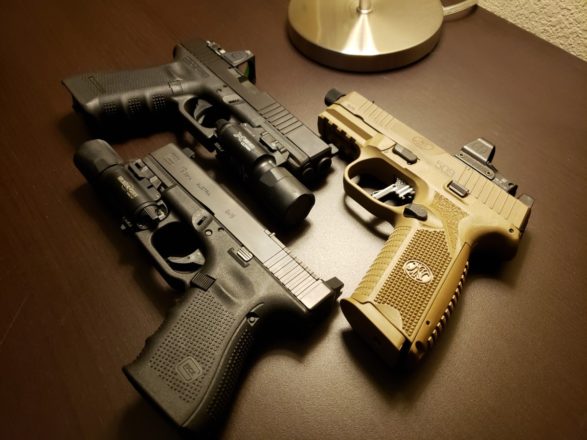
Personnel
Approximately 200 students; mix of federal and local law enforcement, military, mostly civilians, and a surprising amount of /k/ommandos. Classes ranged from eight to fifteen students. The farthest distance traveled I heard from another student was Hawaii, with the next farthest being Juneau, Alaska.
Based on my observations, roughly 60% of students use slide mounted optics for their pistols, with about 25% of that group shooting variations on the Roland Special concept.
11 Instructors ranging from purely competitive backgrounds as well as those with law enforcement and special forces backgrounds. I won’t give bios here for time and space considerations, but you can visit their website for more info about each instructor. Instructors include Mike Pannone, Bob Vogel, Chuck Pressburg, Steve Fisher, Bill Blowers, Craig Douglas, Aaron Cowan, Dan Brokos, Jared Reston, Kerry Davis, and Scott Jedlinski.
Shooter Symposium 2019 Registration
The first day of the Shooter Symposium is an administrative day. Upon arriving I headed over to the vendor tent to see what all was available. While there I chatted with Steve Fisher and Chuck Pressburg who let me handle his Chambers Custom pistol before we headed over to the safety briefing. Afterward, I briefly caught up with Craig Douglas after taking his ECQC last year and then headed to the zeroing range.
Several of the ranges feature small competitions for prizes, with both pistol and carbine stages available. There was quite a bit of confusion about where competitions and zero ranges were located, but eventually, everyone found where they needed to be.
During lunch, the Kommando Blog patch on my range bag grabbed the attention of Mark from Weapons Grade Waifus and Rummy from Shit Gun Normos Say, which led to great conversation, patch swapping and gear comparison through dinner. The night is capped off by prizes for the winners of the day’s competitions and raffles. Several SOLGW rifles, Surefire suppressors, lights, etc were given away (roughly $20,000 worth of gear), and nobody left empty-handed–so long as they hadn’t lost their raffle ticket. I won a Tenicor Velo, which has been my EDC holster since.
Mike Pannone: Covert Carry Low Light (Day 1)
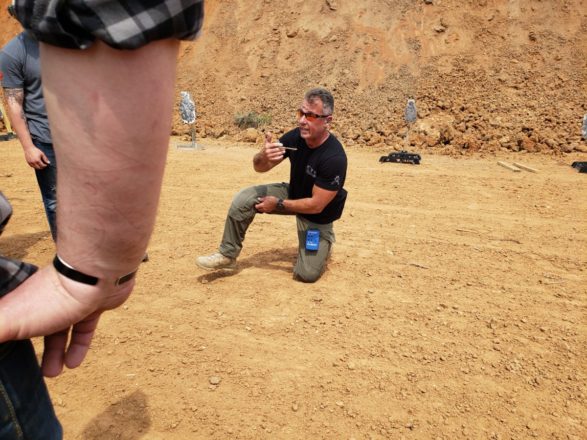
The first training day of the Shooter Symposium starts late for me. Classmates show up at lunchtime then hang out for a few hours until it’s time to begin around 1400. Before starting, Mike Pannone checks everyone’s triggers to ensure they are safe. The logic being he has had several students with shoddy trigger jobs that create unsafe pistols, with some discharging without having the trigger pressed.
We start with the basics; clearing concealment, the draw stroke, and reholstering. Everything is done with partners that way we keep each other accountable for bad reps, acting as pseudo assistant instructors while Pannone makes his way up and down the firing line. Throughout the afternoon we work on balance and removing excess motion (one-foot drill), one-handed drawing, shooting, and reloading, and malfunction drills. Once the fundamentals have been instilled we begin racing our partners for time in what Pannone calls “Rabbit” drills.
To wrap up the first portion of class each student got three attempts at a timed one-shot draw at 10 yards. My best from concealment was a 1.93, with the worst being a 2.23 requiring a second shot.
Low Light Shooting With Noner
After roughly four hours we break for dinner and return in the failing light to begin low light portion of the class. All light techniques shown are handheld techniques, no weapon-mounted light discussion was had. After Pannone finished instruction for the night, I asked about WML techniques, and he said we were free to practice all we wanted on the range until someone stopped us.
Despite the lack of WML training, handheld training was excellent. The lighting environment was the most realistic I’ve had in a low-light class, and it is obvious that Pannone is an expert on the subject. Everything has a reason and a logical one at that.
I had zero issues with my RMR washing out when backlit by the handheld light, nor when using my WML. I never noticed my night sights when looking through the RMR window unless I was specifically searching for their green lamps.
What Training With Mike Pannone Taught Me
Our shooting area was clearly not prepped for class and still set up as the Vendor range from the night before; we had to rearrange targets for our use. Only steel silhouettes of various sizes and shapes were used, which seemed to surprise Pannone at first, but did not substantially impact his lesson plan.
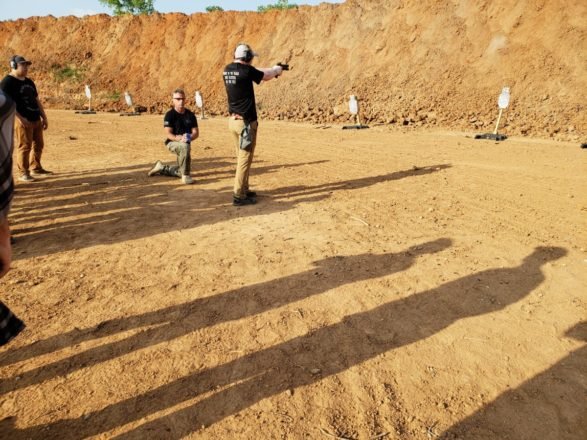
Students did not pick up their trash from water bottles and ammo boxes. Another student and I took it upon ourselves to clean up the area afterward. Be kind to your hosts and the students who will be using the area after you; don’t be that guy.
Pannone is very knowledgeable, mostly no-nonsense, and very focused on the training versus the social aspect. He was there to teach us, not to become our friends. He was fairly easy to talk to and get advice from, particularly for those in Law Enforcement seeking assistance in getting optics for their duty weapons. That being said, there are some techniques he is not interested in seeking alternatives for, specifically the Tap and Rack.
Through my own training, I’ve come to abandon the tap, and simply rack the gun for malfunctions. After seeing me repeatedly do this, and scolding me a handful of times, I proceeded to explain why I avoid the tap (check out Bill Blowers’ video that closely matches my perspective). Pannone’s response is that the Tap and Rack is vetted, and everything else is just “theoretical bullshit”. After our exchange, I continued to rack, and it was never brought up again.
Jarod Reston: Shooting on the Move (Day 2)
Day two of the Shooter Symposium starts with morning thunderstorms surrounding The Ranch. We move our gear down to a covered area at the back of our range. Students get to know each other as we don our equipment and load up our last few pistol and rifle magazines.
Jarod Reston arrives early and fills everyone in on his background. Shooting starts with basics: proper stance, and then cadence drills with our rifles and pistols. Soon we move into the main portion of the class, shooting on the move. The Pace is the Pace–that’s the phrase of the day for both our movement and our trigger fingers. Jarod continually reminds us that shooting fast is important, but not to outrun our brains. You’re accountable for each shot, and shooting too quickly leads to misses.
Movement is substantially faster than any other course I’ve taken. We maintain our dress across the firing line, but everyone’s hearts and pumping at the end of each string of fire. Despite the intermittent rain, spirits remain high, with this group of guys being one of the best I’ve trained with. To top things off, my RMR window stays nice and dry in my Safariland 6390RDS.
My Takeaway After Training With Jarod Reston
Jarod is a great storyteller and a good guy, with real-world examples to demonstrate everything we cover in class. He’s serious about training but quick with a joke and incredibly easy to talk to. It was awesome to see how excited he got over the lewd patch he was given by Mark of Weapons Grade Waifus. Everything was set up properly before class, and no issues arose throughout, making this the most seamless of my courses during the Shooter Symposium.
Kerry Davis: Direct Action Response (Day 2)
After lunch, I head to my last class of the day. Unlike most classes at the Shooter Symposium, Direct Action Response is a medically focused course; the instructor, Kerry Davis is the founder of Dark Angel Medical. The first two hours are all classroom-based; use of tourniquets, hemostatic gauze, NPAs, chest seals, and other medical items. Each piece of equipment gets a brief history of where they started, and how we got to how they’re used today. The academics are informal, but not unprofessional, with students asking questions freely and practicing techniques for every device.
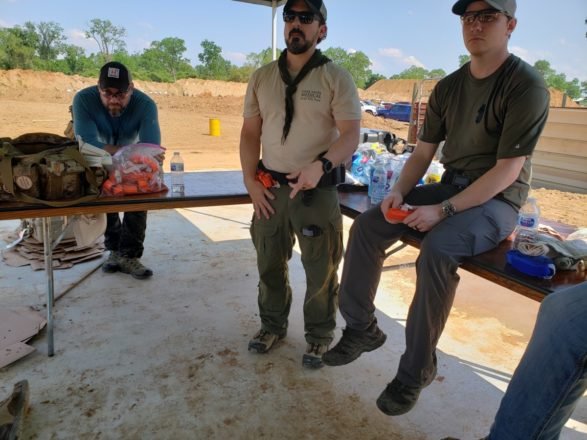
About an hour in Chuck Pressburg stops by to provide his inputs to the discussion, with a specific focus on tourniquets and hemostatics. Two notes that stick out in my mind are:
- Hemostatic gauze stops bleeding 90% of the time with its first use.
- Standard gauze stops bleeding 3% of the time with its first use.
- 68% of improvised tourniquets with a windlass fail.
- 99% of improvised tourniquets without a windlass fail.
Next, we move down to the range. We spend about an hour on the range shooting and performing various emergency medical techniques. Shooting with tourniquet attached to arms and legs to see their effects. Engaging targets from seven to twenty-five yards. Spoiler alert: a properly applied tourniquet is going to seriously impair the use of your wounded limb as it stops the blood flow.
This class was an excellent refresher of some skills and a huge source of new data from legitimate subject matter experts. Kerry and Chuck are seriously smart and seriously hilarious. Everyone walked away with more confidence in our abilities to both make holes in bad guys and plug holes in good guys.
Observations
Kerry originally planned for 8-hour blocks of instruction but was instead given 4-hour blocks. This caused the class to change from being a carbine and pistol course to strictly pistol only.
Scott Jedlinski: Red Dot Pistol (Day 3)
The final day of the Shooter Symposium starts with a continuous drizzle. Class starts with everyone sharing backgrounds, skill levels, and time pistol mounted red dots. Jedi has everyone zero pistols at 10 yards, his reasons are two-fold: most people can’t shoot accurately enough to obtain a 25 yard zero, and having everyone attempt a 25 yard zero would take too much time from the rest of class.
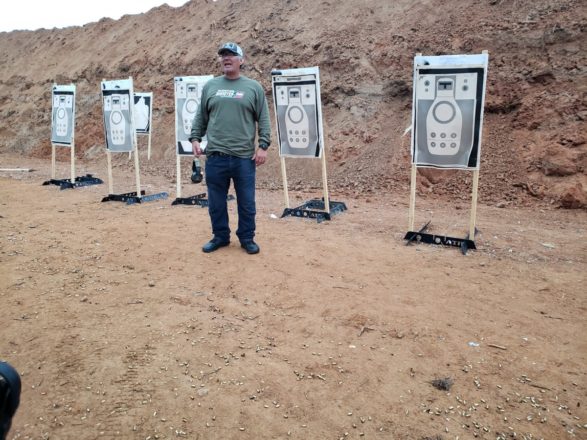
We spend time working on stance and grip for recoil control using some methodology from Jedi’s Brazilian Jiu-Jitsu background. No accuracy standards for our first several strings of fire, simply making sure we can keep the dot within the window.
Once everyone has their guns properly controlled we start working on shooting from concealment with high standards for speed. As we shoot the rain steadily picks up until it becomes torrential; going from simply moistening the soil to submerging my shoes in a matter of minutes. We retreat to the instructor cabin to wait out the storm.
Observations
Jedi can be funny, but also a very serious guy. His shooting was impressive, even with limitations imposed by the rain. His strong personality is divisive among the student body, but presumably, everyone left having learned something. I know I changed several fundamental techniques and am a better shooter for it after his instruction.
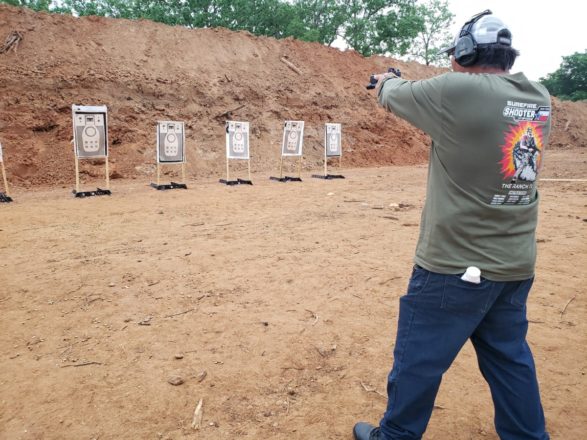
Outside of the rain, the only hiccups from the class were student-related. One student fired his pistol before the command was given–luckily we were getting ready to fire so nobody was in danger, but we lost time as everyone was forced to holster and reprimanded for not listening to commands.
Another student had his RMR go down before class began and did not have a backup pistol. Luckily I had my FN 509T with a Leupold Delta Point Pro and a Henry Holster FN 509 rig that I loaned him for the duration of the class.
The final issue arose when a student failed to vet his training ammo (Silver Bear 115gr 9mm) in his compensated Glock, resulting in several malfunctions. This proved to be an issue throughout the remainder of the class.
Who Can Stop the Rain?
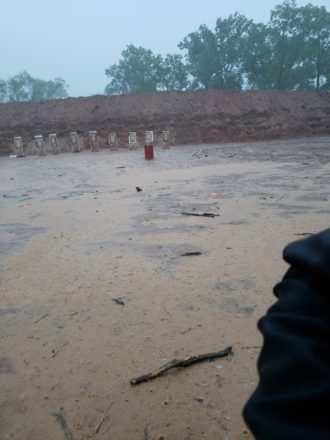
Rain continues for over an hour. The remainder of classes is canceled for safety concerns, as some ranges receive over a foot of standing water. This marks the end of training for Shooter Symposium 2019. During this time I have the opportunity to speak with Steve Fisher, Bill Blowers, and other instructors and students who also fled from rain. We talk about gear, techniques, and future training plans.
Once the rain calms I try to dry my gear and head to leave. A small group of students has gathered on Pannone’s range to ring steel, and I make my way over. We swap pistols, share stories from the weekend, and have a few laughs. After a few hours, and a couple of hundred rounds I say my goodbyes to my new friends and start the long trek home.
Final Thoughts on the Shooter Symposium
Overall the Shooter Symposium was a great experience. I met several awesome people, learned tons, and made great connections. This is a great way to train with multiple world-renowned instructors at a central location.
That being said, it is possible to receive more hours of training from these instructors, for a lower price, by taking their individual classes across the country. But training isn’t all that the Shooter Symposium is about. From the meals and bar to the raffles, the stories around the bonfire and more; Shooter Symposium is an experience, not just an event.
Enrollment is open for the 2020 Symposium, you can find more information about classes, vendors, and prices HERE.
The host range, The Ranch, has classes available throughout the year and offers range use to private citizens. Check out their website HERE
Affiliate Disclaimer: Primer Peak is funded through direct donations and affiliate programs. Some links on PrimerPeak.com are affiliate links. Using one of these links costs nothing extra, the retailer pays a percentage of the sale to Primer Peak. Funding in this manner will assure that factual information is always first. If you would like our Amazon affiliate link or find more retailers on the Support Us page
Support My Work
If you made it this far, thanks for reading! Writing isn’t my full-time profession, and nearly everything I do comes out of my own pocket. Between ammunition, tuition, range fees and more, expenses add up fast. If you like what I have to offer, consider making a donation to my Patreon.
Every bit helps bring more work like this to you, and contributes to shortened timelines or more in-depth work on my part. You’ll also have more direct access to me, offering suggestions for future projects, looking behind the scenes, and getting early access to some content. You can find my Patreon >>HERE<<


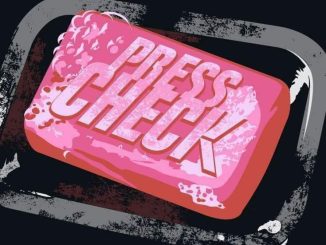


4 Trackbacks / Pingbacks